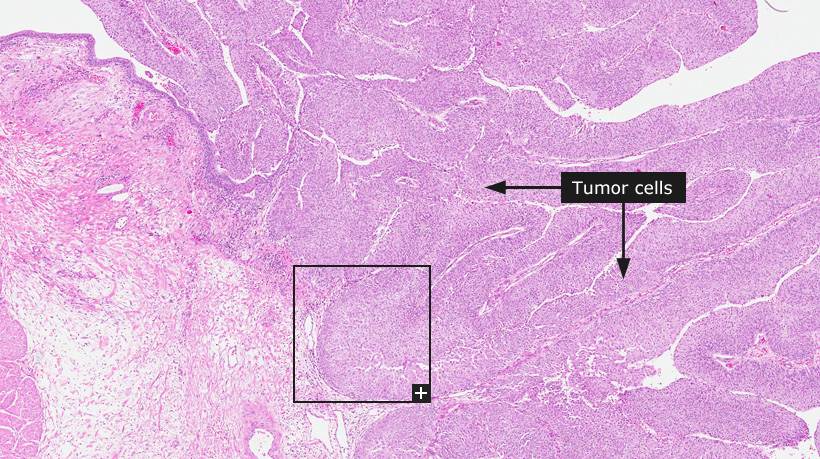Urothelial cancer
Male, 67 years, highly differentiated papillary urothelial carcinoma 
Urothelial cancer
Urothelial cancer, also termed transitional cell carcinoma or urinary bladder cancer, is a major cause of morbidity and mortality throughout the world. The highest frequency of cancer in the urinary bladder is found among urban Caucasians in Western Europe and in the United States of America. Urothelial cancer typically presents in patients over the age of 50 years and is approximately three times as common in males as in females. Smoking is considered as an important risk factor. The majority of patients present with symptoms of hematuria (blood in the urine) and/or dysuria (painful urination). Urothelial cancer most commonly arises in the urinary bladder, but can develop in the renal pelvis, ureters or urethra.
Urothelial cancer can be divided into papillary and non-papillary tumors depending on the morphological appearance. Approximately 25% of all urothelial tumors are non-invasive papillary tumors. However, 10-15% of these patients will subsequently develop an invasive tumor. Papillary tumors appear in cytoscopy with variable size, ranging from minute excrecences to large, cauliflower like tumors protruding into the urinary bladder lumen. Histologically papillary tumors are characterized by tall and branched papillae that are usually covered by several layers of urothelial tumor cells.
Urothelial cancer is classified with respect to surgical stage at time for diagnosis and tumor grade based on histology. Staging of urothelial cancer defines a tumor as cancer in situ, non-invasive, invasive in the lamina propria or invasive into muscular bladder wall. The TNM-based classification provides important prognostic information and guides further treatment. In addition, important prognostic information can also be obtained through grading of the tumor based on morphological features. Tumor cells vary in atypical appearance and are graded according to the degree of nuclear atypia into four different grades, including urothelial neoplasm of low malignant potential. The most malignant tumors are of grade 3 and exhibit at least focal areas of high-grade nuclear atypia and common mitotic figures. Urothelial carcinoma grade 3 represents a tumor with more aggressive behavior and increased risk for recurrence and metastatic spread.
Sarcomatoid variants of urothelial carcinoma exist and, furthermore, squamous cell carcinomas and adenocarcinomas can develop in the urinary bladder. Squamous cell carcinoma in the urinary bladder accounts for approximately 5% of all cancers in the urinary bladder. However, in areas where schistosomiasis is endemic, squamous cell carcinomas account for approximately 75% of all bladder carcinomas.
Normal tissue: Urinary bladder
|